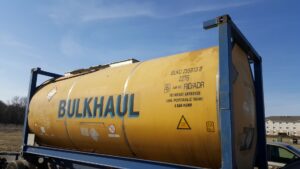The Definition:
The Hazardous Materials Regulations (HMR) of the Pipeline and Hazardous Materials Safety Administration within the U.S. Department of Transportation (USDOT/PHMSA) define a portable tank at 49 CFR 171.8.
Portable tank means a bulk packaging (except a cylinder having a water capacity of 1000 pounds or less) designed primarily to be loaded onto, or on, or temporarily attached to a transport vehicle or ship and equipped with skids, mountings, or accessories to facilitate handling of the tank by mechanical means. It does not include a cargo tank, tank car, multi-unit tank car tank, or trailer carrying 3AX, 3AAX, or 3T cylinders.
Contact me the next time your USDOT, IATA (air), or IMO (vessel) training is due to expire. |
So lets break it down…
- A portable tank is a bulk packaging. A bulk packaging is also defined at §171.8 and explained in this article: Bulk Packaging for HazMat Explained! But for the purposes of this article a bulk packaging has a maximum capacity of more than any of the following:
- 450 L (119 gallons) as a receptacle for a liquid.
- 400 kg (882 pounds) and 450 L (119 gallons) as a receptacle for a solid.
- Water capacity of 454 kg (1,000 pounds) as a receptacle for a gas. Note: a water capacity of 454 kg (1,000 pounds) calculates out to a volume of 450 L (119 gallons).
- However, a portable tank may be a non-bulk packaging if it is a cylinder (defined at §171.8) with a water capacity of 1,000 pounds or less.
- A portable tank is not designed to be permanently attached to a transport vehicle or ship. This differentiates it from the cargo tank which is permanently attached to or forms part of a vehicle.
- A portable tank is equipped with the following:
- Skids
- Mountings
- Accessories to facilitate handling of the tank by mechanical means.
And finally…
- A portable tank is not any of the following:
- Cargo tank
- Tank car (rail)
- Multi-unit tank car tank (rail)
- A trailer carrying 3AX, 3AAX, or 3T cylinders
Q: Could a cylinder be a portable tank?
A: No. The definition (as of 06.06.20) is unclear as to whether a cylinder could ever be a portable tank. The opening sentence refers to a cylinder having a water capacity of 1000 pounds or less, which is a non-bulk packaging. It seems to be saying that a portable tank is a bulk packaging but it could also be a cylinder if it is a non-bulk packaging. Also, the last sentence specifically excludes the packaging types a portable tank is not. Included here is a trailer carrying 3AX, 3AAX, or 3T cylinders, but not all cylinders. It seems to leave open the possibility that some non-bulk cylinders could meet the definition of a portable tank. Conversation with USDOT/PHMSA HazMat Info Line revealed the following time-line to the progression of the definition of portable tank:
- The original definition published in 1976 did not include the reference to bulk packaging since that term did not yet exist. The reference to cylinders was present then.
- In 1987 the definition of portable tank was modified to include the reference to bulk packaging but the misleading references to cylinders remained.
In conclusion: disregard the reference to cylinders in the definition of a portable tank. A portable tank can’t be a cylinder. USDOT/PHMSA will correct this error in a later rule change.
Like this article? Subscribe to my Monthly Newsletter No marketing emails! |


